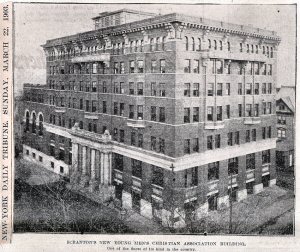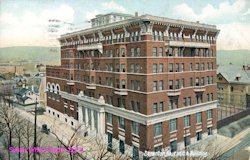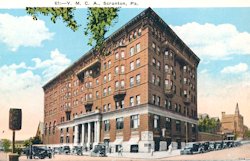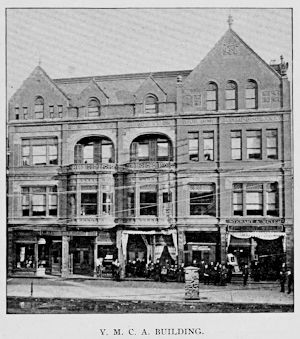| First
Scan: Scranton,
Penn., March 21 (Special). The young men of no city in the country are
so fortunate as those who live in this hustling city of factories and
mines.
At least one can find few in Scranton who will admit it.
At a cost of $320,000, most of which came out of the
purses of generous
citizens, a home has been erected for the Young Men's Christian
Association.
What this expenditure means for a city of this size will be realized
when
one figures that had every citizen contributed an equal share an
assessment
of more than $3 from each man, woman and child would have been
necessary.
Again, it would have cost at least $600,000 to erect a similar building
in New-York in anything like as convenient a locality.
The building was dedicated a few weeks ago, and the work
of furnishing
it has just been completed. It is said to be in most respects the
finest
Young Men's Christian Association building in the country. Certainly
there
are none more modern and thoroughly adapted to the work of this great
Christianizing
influence. Some one has said that in this Scranton is twenty years
ahead
of cities of her class, and for that the young men here rejoice.
No one mind planned this marvel of utility. The best
Young Men's Christian
Association and similar buildings in the country were studied. Then
came
an architectural competition, in which forty-four sets of plans were
submitted.
Professor A. D. F. Hamlin, of Columbia University, was the judge, and
made
four awards. The final plans were made up from these, and the building
erected under the personal direction of George S. Maby, a general
secretary
of the association. He acted as superintendent of construction, and
saved
the building committee not less than $6,000.
The building is of simple architecture, but dignified
and with massive
effect. It is only two blocks from the heart of the city, and so well
within
the business district that the store rooms on the street floor were
rented
before the building was finished. The main building has seven stories,
with a roof garden on top, which will be used in summer for open air
gatherings.
The gymnasium section is half as high. The main entrance is marked by
four
white stone pillars and a broad flight of stone steps. The outer loggia
is highly decorated, and the whole forms the finest architectural
detail
to be seen in Scranton.
|
Second
Scan: A detailed
description of the building would be interesting, because every
department
introduces something new. There are features, however, which stand out,
and one of them is the living rooms for young men in the upper floors.
It is goodby to the cheerless, frigid hall bedroom, the
bugbear of the
young man away from home. Scranton youths are no longer dependent. They
can find accommodations in this building for as little as $5 a month.
They
can pay more for larger rooms and private baths, but the $5 men will be
much more comfortable than they ever were before.
In order to live for $5 a month a young man must have a
roommate. He
gets no private bath, of course, but there are tubs and showers on each
floor, which he is welcome to use, and tickets for the plunge in the
basement
are eight for a quarter. For $8 a month a man can have a single room,
and
$18 gets a large outside room with private bath. Many of the rooms are
arranged in suites, and by bunching the beds, as college boys usually
do,
a sitting room is possible. The rooms are papered in bright colors,
furnished
with brass beds, bureaus and easy chairs, and every one has an open
outlook.
For the exclusive use of the young men who live in the
building there
are three parlors on the second floor. They can entertain their friends
without the necessity of bidding with the landlady's daughter for the
front
room privileges. The service is almost as complete as is offered by the
ordinary hotel, there being a system of electric bells connecting the
rooms
and the office. There are no restrictions except that the men behave
themselves
as gentlemen. All those who have rooms must be members of the
association.
That the young men appreciate this department is shown by their taking
two-thirds of the rooms before the building had been opened two weeks.
Another feature of the building is the auditorium, which
occupies the
entire eastern end of the buildings. It is finished in green and gold
and
is as attractive as any Scranton theatre. The seating capacity is 720,
which is large enough for the general meetings of the association and
for
the lecture audiences which will gather there.
Some Scranton citizen, whose philanthropy has athletic
tendencies, gave
$35,000 to fit up the gymnasium in the most improved fashion. The first
floor is devoted to a swimming pool, 40x20 feet, and the depth varying
from 3 to 12 feet. On the same floor there is a marble room for Turkish
baths. The "gym" proper is 51x76 feet, with a ceiling 40 feet high.
There
is a padded running track, with banked turns running around the room at
a height of 15 feet, and above that is a gallery for visitors.
The public reading room o the first floor is a feature
which will be
appreciated by the public. The educational end of the association's
work
will be cared for in nine classrooms. There are several amusement
rooms,
a smoking room just under the roof, as fine bowling alleys as can be
found
in the State, and a whole floor given over to the junior members, where
they can make all the noise they like without disturbing the seniors.
The association will be self-supporting in this new
building. The total
rentals will bring in $18,500 a year, and the expenses of the building
will not run over $11,500. This leaves a balance of $6,500, to which
must
be added an income of $10,250 from membership and class fees. The work
of the association cannot be carried on for less than $15,500, which
leaves
a margin of $1,250.
|



